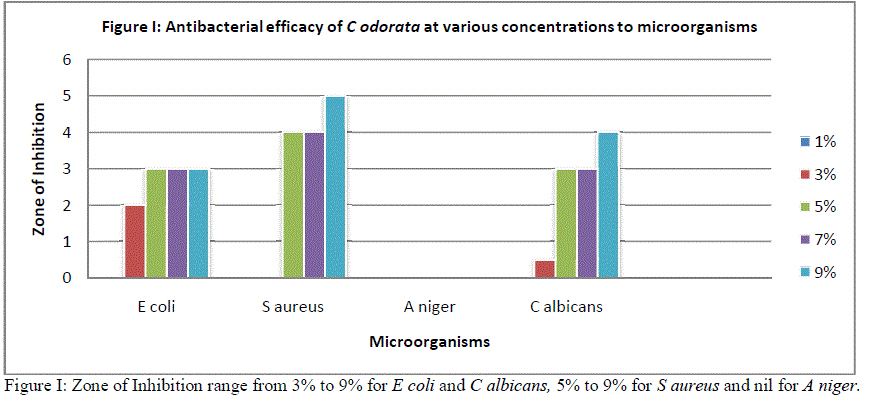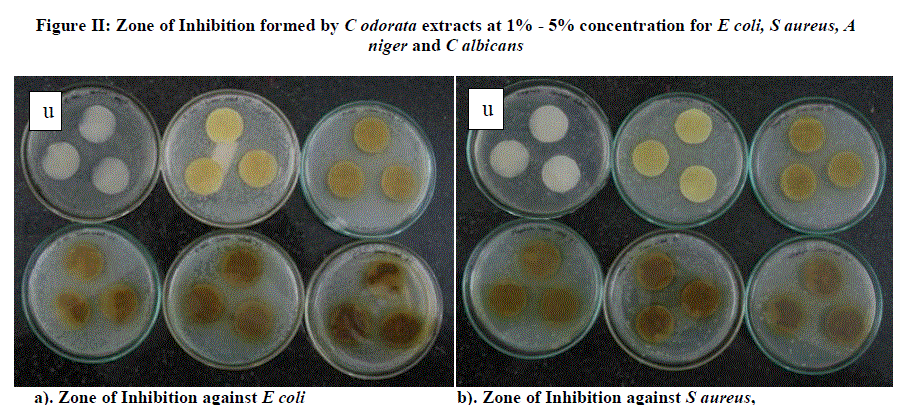ISSN ONLINE(2319-8753)PRINT(2347-6710)
ISSN ONLINE(2319-8753)PRINT(2347-6710)
Resmi. G1 and Dr. S. Amsamani2
|
| Related article at Pubmed, Scholar Google |
Visit for more related articles at International Journal of Innovative Research in Science, Engineering and Technology
Methanolic extracts of Chromolaena odorata were tested for potential use as an antimicrobial agent on viscose fabric. Various concentrations of the extracts from 1 % to 9% was taken and treated on viscose nonwoven fabric with the aid of ultrasonic atomizer. The antibacterial and antifungal assay (AATCC test method 90 -2011, Agar test method) of the treated fabric was done against Escherichia coli, Staphylococcus aureus, Aspergillus niger and Candida albicans. The zone of inhibition formed were E. coli (3mm), S. aureus(5mm),Candida (3mm)and no zone were formed for A. niger. 5% of Chromolaena odorata extracts can be used as a natural antimicrobial agent on textiles which can be used for medical applications
Keywords |
| Chromolaena odorata, herbal extracts, Ultrasonic atomizer, herbal antimicrobial agent, nonwoven viscose fabric. |
INTRODUCTION |
| The plant kingdom is a virtual goldmine of potential drug targets and other active molecules waiting to be discovered [1]. Regardless of the availability of a wealth of synthetic drugs, plants remain even in the 21st century an integral part of the health care in different countries, especially the developing ones [2]. Use of plant products for the control of human and animal diseases has certain advantages. Antibacterial agents remain the mainstay in the treatment of bacterial infections. The emergence of drug resistant bacteria has become a medical catastrophe [3].The wise full use of antimicrobial agents in minimum precise quantity holds significance to control the super bugs among the microorganisms. There is a need to identify newer drugs for bacterial diseasessuch as biodegradability, availability, low toxicity and cost effectiveness [4]. Chromolaena odorata, is one of the world’s worst tropical weeds and is being used traditionally for its many medicinal properties, especially for external uses as in wounds, skin infections, inflammation etc. Studies have demonstrated that the leaf extract has antioxidant, anti-inflammatory, analgesic, anti-microbial, cytoprotective and many other medicinally significant properties [5]. |
| Textiles play an important role in the daily lives of humans, and the demand for various quality attributes of them are based on enhancing the properties through proper finishing. Textile goods are excellent substrate for growing microorganisms. The prevention of microbial attack on textile materials has become increasingly important to consumers and textile producers [6]. The most important cellulose fibres in medical applications are natural cotton fibers and different regenerated (manmade) cellulose fibres such as viscose, modal, and lyocell. Moisture, liquids adsorption, antistatic behaviour, low content of dyes and other chemicals, high mechanical stability, ease of laundering and/or sterilization are the significant characteristics which determine the medical application of textile fibers [7].Viscose is a dominating fibre in the field of wipes and medical nonwovens [8] The high absorbency, excellent softness and cleanliness compared with other natural and synthetic fibers made viscose one of the most desireable fiber for nonwoven applications [9]. |
| Nonwovens are heart of the medical and hygiene sector and it is a part of medical textiles, which find applications predominantly in disposable and health care sectors and it will be playing vital role in coming decades in technical textiles. [10]. The advantages of spun laced viscose fibre web are obvious for medical and surgical applications [11].The vey main objective of medical textiles is to improve quality of health care delivery through disposable products and enhance the standard in health care delivery by minimizing the risk of infections.[12] |
RELATED WORK |
| Coating of antimicrobial plant natural dyes and bioactive plant extract on to cotton fabrics is an emerging technology in the production of medical cloths.Pomegranate rind extract coated on cotton fabric was found to be effective as antimicrobial finishing of textile, followed by neem and turmeric [13].Solvents such as methanol, ethanol, ethyl acetate, hexane and chloroform with extracts of Chromolaena odorata were tested against clinical bacteria (Escherichia coliand Staphylococcus aureus) and phytopathogenic bacteria (Xanthomonas vesicatoriaand Ralstonia solanacearum).Among treatments, maximum In vitro inhibition was scored in methanol extracts ofC. odorata which offered inhibition zone of 8mm, 7mm, 5mm and 7mm against tested bacteria E. coli, S. aureus,X. vesicatoria and R. solanaccearum, respectively [14]. |
| Preliminary phytochemical screening of the extract gave positive reactions for alkaloids, flavonoids, tannins, 4-hydroxybenzoic acid, and glycosides. These phytochemicals may be responsible for the observed inhibition of total dehydrogenase enzyme activity that translates to antimicrobial action in these pathogenic organisms [15]. |
SCOPE OF RESEARCH |
| • To develop herbal antimicrobial agent for textile finish from underutilized plants |
| • To optimise the concentration of herbal antimicrobial agents |
| • Application of herbal antimicrobial agent on textiles |
| • Evaluating the efficacy of treated textiles over microorganisms |
| • To utilize the developed herbal antimicrobial agent for hygiene textile products/ medical textiles |
METHODOLOGY |
| Materials: |
| Chromolaena odorata leaves, Methanol (99.9%),Escherichia coli(NCIM No. 2065), Staphylococcus(NCIM No. 2079),Aspergillus niger(NCIM No.596) and Candida albicans(NCIM NO. 3471)Soxhlet apparatus, Spun laced viscose fabric, Ultrasonic atomizer. |
| Extraction of bioactive agents: Fresh leaves of Chromolaena odorata collected form Palakkad District of Kerala during the month of July 2012, were washed thoroughly in running water and rinsed in distilled water. It was dried shade for one week and then powdered. 25 g of shade dried, powder of plant materials were filled separatelyin the thimble and extracted successively with 150 ml each of methanol using a Soxhlet extractor for 48h. After complete solvent evaporation, the extract was weighed and preserved at 4oC in airtight bottles until further use [16]. The extract was then ultrasonicated to breakdown the particle size and then filtered. Redistillation was done to remove the methanol from the herbal extracts to obtain crude extracts which were stored in sealed containers at 4 degree centigrade. The total extract concentrate yield per gram of dried plant material was determined using the formula: [weight (g) of dried extract/dryweight (g) of plant material] x 100 [17]. |
| Optimising the concentration: |
| Preparation of solution: Optimisation of the crude extracts was done to arrive at the actual concentration required for the plant extracts to act as antimicrobial agents on textile substrates were done at 1%, 3%, 5%, 7% and 9%. The weighed crude extracts were ultrasonicated with methanol to dissolve it. |
| Application of bioactive agents on fabric: |
| The prepared extracts was applied on viscose nonwoven fabric surface using Ultrasonic atomizer with the inlet pump immersed in the extracts and the liquid dispensing speed was set at 10 ml/ minute, the evenly sprayed extracts for each concentration was applied to the fabric surface and dried at room temperature, noting down the fabric weight before and after finishing. |
| Antimicrobial assessment of the finished fabric: |
| The antibacterial assay of the bio extracts treated fabric and untreated fabric was analysed against Escherichia coli(NCIM No. 2065),Staphylococcus (NCIM No. 2079),Aspergillus niger and Candida albicans as per AATCC Test Method 90 – 2011, Agar plate method. The zone of inhibition was measured for all the organisms. |
EXPERIMENTAL RESULTS |
| Yield of the extracts |
| Out of 25 grams of C odorata dried leaves, the air dried crude extracts obtained was 4.715 grams (18.86% yields). |
| Antimicrobial Efficacy |
| The Chromolaena odorata extracts treatedspun laced viscose fabricshowed good antimicrobial activity at 5% concentration inhibiting all the strains except A niger. An increase in zone of inhibition of 5mm (S aureus) and 4mm (E coli) was observed with an increase in concentration to 9%, however it failed to increase for the same with Calbicans (3mm). Hence the optimum C odorata concentration for imparting antimicrobial finish for spun laced viscose nonwoven fabric was found to be 5% (Figure I) |
 |
 |
CONCLUSION |
| The antimicrobial efficiency of Chromolaena Odorataextractscan be effectively utilized as potent herbal antimicrobial agent for textile finishing. The treated antimicrobial fabric can be used for fabricating medical textile products like wound dressings, health and hygiene products. |
ACKNOWLEDGEMENT |
| The support by University Grants Commission – Junior Research Fellowship is gratefully acknowledged. |
References |
|